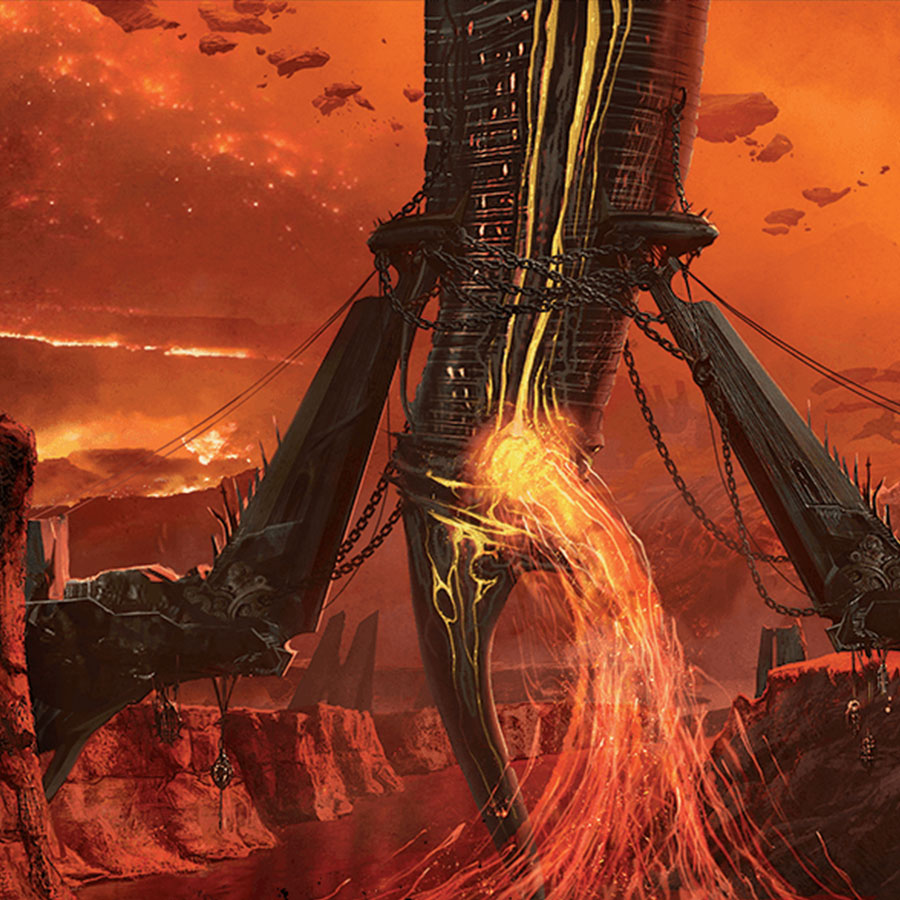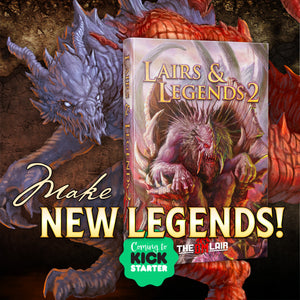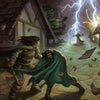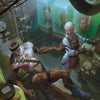How the Hickman Revolution Changed D&D Forever

Written by Luke Hart
The Hickman Revolution was supposed to fix everything—or at least make Dungeons & Dragons better. Instead, it changed the game forever, and not always for the better.
While its creator, Tracy Hickman, laid out a thoughtful, four-point manifesto aimed at enhancing story, structure, and player engagement, the RPG community misread the fine print. Over time, what began as a call for richer, more meaningful adventures was twisted into an obsession with plot armor, railroaded campaigns, and nearly unkillable characters.
In this article, we’ll explore what the Hickman Revolution actually was, where it went wrong, and why it still sparks debate among grognards and modern GMs alike.
By the way, are you a NEW GAME MASTER feeling a bit overwhelmed by everything involved with running a role-playing game? If so, the Secret Art of Game Mastery can help. Get over 100 years of GM experience distilled into practical, easy-to-read advice.
Watch or listen to this article by clicking the video below.
No one can argue that the Hickman Revolution, commonly ascribed to Tracy Hickman, co-creator and author of the famed Dragonlance setting and novels, revolutionized D&D and other RPGs and transformed them from their early wargaming roots into what we have today.
This revolution had several very desirable and beneficial impacts to the game—which we will discuss in just a bit—but it also had a decidedly negative impact. In fact, many D&D and RPG grognards and OSR enthusiasts use the Hickman Revolution as a derogatory term and blame it for taking the game in undesirable directions. Some would say that it ruined D&D.
However, those undesirable effects—which I would agree were quite undesirable and certainly took the game in a direction that wasn’t in the best interests of gameplay—wasn’t Hickman’s fault nor intention. It happened because people either ignored what was convenient to ignore, or simply weren’t paying attention to half of what Hickman put forth in his manifesto. But before we can get into that, we need to lay a foundation on what the Hickman Revolution actually was.
It all began with the Hickman Manifesto, which was composed of FOUR POINTS written in the introduction of Pharaoh, an adventure that Tracy had written, intending to publish it under his own label, but that TSR really wanted, offered a lot of money for, and ended up buying. However, the original introduction was never officially published, though copies do exist – which is how we know what it says.
The first point of the manifesto is that there should be “a player objective more worthwhile than simply pillaging and killing.”
When D&D was just getting going, this was often the only player goal: kill stuff and take their loot. No other motivation was needed. There’s a dungeon over there? Okay, cool. Let’s head over, kill everything in it, and take their treasure. Or maybe just sneak around, avoid fighting—because combat was far more challenging and lethal in the early days—and try to steal their treasure from under their noises.
Hickman instead purported that there should be more variety in player goals and objectives in the game. Perhaps stopping the evil druid who seeks to corrupt the forest; rescuing a baby dragon from its cruel captors; or finding the king’s missing amulet. The details will vary from adventure to adventure, but it shouldn’t just be: kill and pillage.
The second point of the manifesto is that there should be “an intriguing story that is intricately woven into play itself.”
Hickman realized that having an interesting plot or story around that aforementioned dungeon would serve as a better motivator for players, improve the enjoyability of the game, and result in a more satisfying ending. And it so happens that having an intriguing story is often tightly coupled with the first point: player objectives that involve more than pillaging and killing. Once we start talking about an evil druid corrupting the forest or rescuing a baby dragon from its captors or finding a king’s amulet, we’re starting to introduce PLOT and STORY into the game. And I think most people, including me, would agree that having an interesting storyline improves the game by leaps and abounds. So far, so good.
The third point of the manifesto is that “dungeons should make architectural sense.”
Does anyone remember those nonsensical dungeon maps composed of several seemingly random rooms connected by long corridors with odd twists and turns? And the same long corridors often connect the same few rooms. If you haven’t seen these, you can usually reproduce them with random dungeon map generators online. Like, why would ANYONE design a dungeon that way? And here’s the thing, when players encounter dungeons like that in the game, it breaks immersion, ruins believability, and disrupts verisimilitude. Thus, dungeons that make architectural sense contribute much better to the overall game experience than nonsensical dungeons composed of random rooms and hallways. So a great point three in the manifesto.
The fourth point of the manifesto is that there should be “an attainable and honorable end within one to two sessions playing time.”
And what is “an attainable and honorable end” supposed to mean? It means that any given players’ character—the barbarian, the fighter, the wizard, or the cleric—should be able to witness the fulfillment of the plot or story the DM has put into motion. That also kind of means, they probably shouldn’t die, but should live to see the resolution. Was the evil druid stopped? Did they rescue the baby dragon? Did they retrieve the king’s amulet? If the characters attain this ending, it makes for a more satisfying game experience.
And I completely agree with this point, too. In fact, I agree whole-heartedly with all four points—and I suspect 95% of RPG gamers do, too. So, if all four points of the Hickman Manifesto make for a better game, how do they get a bad rap?
The Hickman Revolution gets a bad rap and takes the blame because everyone seems to IGNORE an important part of point four: those last seven SUPER IMPORTANT WORDS: “within one to two sessions playing time.” And what does that mean? What generally lasts one to two game sessions? Well, that must be the individual ADVENTURE, not the entire campaign. So, what the Hickman Manifesto is actually saying here is that the intriguing STORY, the plotline, should span a few gaming sessions—a single adventure—and then come to a satisfying ending. And, by extension, it is understood that it would be ideal for characters to survive to witness the fulfillment of that storyline in that adventure.
And yet, because we always want MORE, that story that Hickman intended to last a few game sessions, keep getting longer and longer. It began to span several adventures. Then it came to encompass the entire CAMPAIGN where you have a story or plotline that carries throughout the entire game, from level 1 to 20. And along with this came the EXPECTATION from players that their characters should survive to witness this entire story unfold and come to a satisfying ending.
And, of course, this led to game design decisions from edition to edition. If you’ve played D&D long enough, you’ll have certainly noticed that with every subsequent edition of the game, it gets harder and harder to kill PCs. The game gets less and less lethal, and the PCs become more and more likely to live through the entire campaign. And with 5th edition as we currently have it, I can confidently say having DM’d the game for multiple groups for over half a decade, that it is nearly impossible to kill PCs. These game design decisions were, naturally, influenced by players who WANT the story and WANT to see their characters live through the entire campaign to see it all conclude.
Now, as players of the game, reactions to this non-lethal trend generally fall into two camps: people who love it and have no issues with it, and people who hate it and feel it makes the game less enjoyable. And, of course, there are spectrums in between. To generalize just a bit, younger folk tend to like the game this way, and older folk tend not to. I personally have made a couple videos explaining why PC death and the ever-existent threat of PC death IMPROVE the game, so I certainly lie toward the latter end of the spectrum. I still love story, and for sure, my games all involve lots of story, but my games are also challenging and there are no guarantees your character is going to survive. I try to mix the best of both worlds.
The other thing that happened when the story shifted from spanning just a few game sessions to spanning THE ENTIRE CAMPAIGN, is that game masters seemed to have been replaced by frustrated novelists. You see, it used to be that the principal job of the dungeon master or game master was to run a fun GAME for the players which featured objectives, freedom, challenging gameplay, and open-ended design. However, that has shifted more and more to simply telling an interesting, pre-defined STORY. The game elements have faded into the background, and THE STORY has become king. It’s almost as though people who didn’t have the talent, time, or dedication to become authors and novelists turned instead to RPGs to tell their stories. Here they could craft the plot of their choosing and have a captive audience—the “players”—who could then witness the unveiling of the story from beginning to end as they were railroaded handily along. And this trend and problem that has developed in our hobby isn’t the fault of Hickman either, I might add. It’s our own darn fault.
But anyway, THIS is why the Hickman Revolution—which carried the game away from its traditional sandbox-style play towards a GM-plot-driven obsession with story, essentially a railroaded narrative, and away from the challenging game it used to be—is often blamed and used derogatively by gronards, old school gamers, and the like. Because they IGNORE the fourth point. These undesirable changes, from their point of view, toward a railroaded narrative and storyline, instead of a game that allows the players agency and choice ARE NOT THE FAULT OF THE HICKMAN MANIFESTO. If we are to ascribe fault, the fault lies with everyone who ignored the fourth point and expanded the story and plot to encompass the entire campaign, and not just a couple game sessions. The fault lies with people who in lieu of writing novels choose to run railroaded D&D games where everything serves the purpose of the story they want to tell.
And THIS is why I argue that the Hickman Revolution failed, that the Hickman Manifesto didn’t obtain all of its goals. Because story was never intended to become the all-encompassing, all-important focus of the game that it is today. Because PCs were never intended to become invincible super heroes that couldn’t be killed. This was never Hickman’s goal. So let’s stop blaming him.
100 Years of GM Experience at Your Fingertips!
Are you a NEW GAME MASTER feeling a bit overwhelmed by everything involved with running a role-playing game? Are you a VETERAN GAME MASTER looking for new tips and tricks to take your games to the next level? Look no further than the Secret Art of Game Mastery.
We at the DM Lair have distilled our CENTURY of accumulated GM experience into an easy-to-read guide of practical advice that you can immediately apply to your games! We've even included our own templates–the things that we use to prepare our ACTUAL games.
Get all three books to master your game:
- The Secret Art of Game Mastery. Contains over 100 years of GM advice distilled into an easy-to-read format. It introduces and explains the tools of the trade, scheduling, playstyle, post-game notes, getting player feedback, and more.
- The Secret Art of Preparation. Brings to your fingertips the actual templates and guides that the DM Lair team uses to prepare games, Lair Magazine, and more. Designed as a three-ring binder, it's intended for you to write directly into for your entire campaign!
- The Secret Art of Notetaking. Gives you the keys to tracking your campaign from session to session just like the DM Lair team. Designed as a three-ring binder, it's intended for you to write in and keep track of your whole campaign!
With so much knowledge and experience on its pages, The Secret Art of Game Mastery is guaranteed to become an indispensable tool for all game masters, new and veteran alike. And if that isn’t enough, the information applies to all game systems and all genres!
-
Posted in
Game Master How-To Articles







